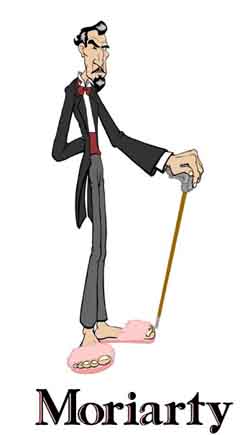Hey, everyone. "Moriarty" here with some Rumblings From The Lab.
I’m really quite puzzled by this series of films. The descriptions just don’t make any sense to me. I have a feeling it’s one of those things you have to see for yourself, and even then, reactions sound like they’re intensely personal. I haven’t heard two people that even sounded like they saw the same films, much less had the same reactions. Check this out:
About two years ago I was lured by a production still and little or no description to Seattle's long standing indy theater, The Grand Illusion, where I saw one of the most stunning films I have ever been fortunate enough to see, and that film was Cremaster 2. Following this I searched obsessively for any details about the elusive Mr. Barney and his rarely screened films, and I regaled any who would listen about what I had seen. But to borrow a quote from a recently serialized film, "no one can be told what 'it' is, you have to see it for yourself...". I was overjoyed to hear that for the first time in the United States the entirety of the Cremaster Cycle would be screened at the Guggenheim (this was prior to the announcement of the Palm pictures deal and Sundance...) I rounded up every one I could and headed for NYC. (This was no small feat for we are mostly part of Seattle's overeducated army of service personnel, no trust fund babies here.)
My approach to evaluating any film is in this order: Visual style, Scoring, and Plot. This may be backwards I know but this strategy has never failed me in recommending films to others. As a caveat to these films I would say that if you are incapable of enjoying a film outside its narrative structure, than these films are not for you. Some professional reviewers have referred to these films as "narratively opaque" and a trip through the opening essay in the companion book to the Gugggenheim exhibit ($45 on Amazon!) will demonstrate that in this case interpretation is best left to those with doctorates in art theory and philosophy. That said I never once felt alienated by the content of these films, for like any good mythology it speaks to the subconscious as much as the conscious. But if you enjoy the films of Cronenberg, Cocteau, and Kubrik (and I belive someone associated Jodorowsky) you owe it too yourself as a cinema buff to see these films. (the following contains ah...'spoilers', if there could be such a thing in these films...)
As for individual reviews (not in sequential order) there are moments not to be missed in each film:
Cremaster 1: Can only be described as the most obtuse sex-education film in history, and clocks in as the shortest of the 5 and bears the most resemblance to Barneys background as a performance artist, and has some of the best visual pacing in the series.
Cremaster 2: The opening sequence, and the square dancing scene (in a revolving room) are just stunning.
Cremaster 3: The "epic" of the series, this one contains the most disturbing images, but the zombie sequence, a scene were they 'play' the Chrysler building as a musical instrument, an inspired slapstick performance, and Barneys 'transformation' through a graphically realized masonic ritual, sculptor Richard Serra's building towers out of lead plates, and the 'Order' sequence that was shot in the Guggenheim are some of many marked indelibly in my memory. This one should be the last one you see.
Cremaster 4: This again returns to the biological model of the first film and is the most "art film" of the cycle and is a visual metaphor for the 'core' idea behind the films.
Cremaster 5: This from every standpoint is my favorite of the cycle, and is visually intoxicating, and the best scored of the series. If you see only one of these films, let this one serve a window for you into the complex and personal mythology of Matthew Barney.
In an age when 90% of the films made in this country are not worth the celluloid there exposed on, it is important that we support artists like Barney, for if you see all the films it is easy to trace his maturity as an artist and filmmaker and I for one cannot wait to see where he goes from here. As to the question posed by the previous reviewer, I truly hope we will be watching these films 40 years from now. Please support the decision of Palm pictures to release these films, if you do not we may have another Brakhage, were everyone emulates him but we will have seen about 5% of his work. I hope this review is of some use to you ar at least piques your curiosity enough to see these films for yourself.
If you do post this, My handle is Hopfrog, and Im sorry I sat on this review since February.
No worries, man. I’m glad you stepped up and sent it along now. It’s definitely a provocative description of what sounds like a difficult chunk of work.
"Moriarty" out.

